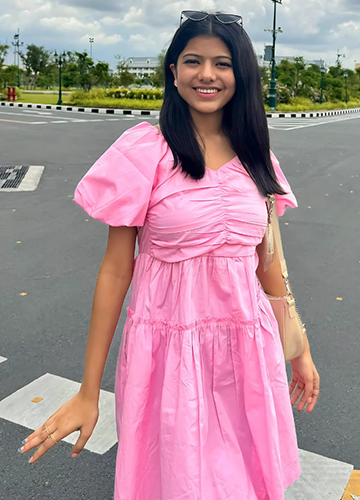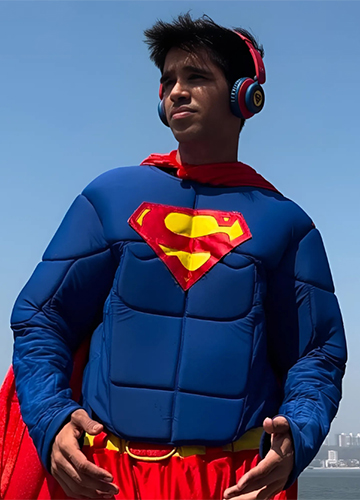Tanisha Singh was disappointed when Zytus, the first company to visit her campus for placements, rejected her despite clearing six rounds of the process. “I was devastated. It was the first company, and I had no idea how to handle rejection,” recalls the 23-year-old engineer.
Four of her batchmates were hired by Zytus, including her close friend Amit. When she asked him how he had cracked the process, he told her that his HR round was “super easy”. That conversation sparked an idea. “I thought, ‘Why not start asking people how they got placed?’ It could help juniors have a roadmap―how to approach placements, handle rejection and learn from others’ experiences,” says Singh.
But little did she know that she was stepping into the unique domain of ‘vox pop’ content creation, a journey that would not only bring her popularity and brand collaborations, but also make her (@tanyy_) a collector of beautiful human stories.
Vox Pop―short for vox populi, meaning voice of the people in Latin―has a rich history in media, particularly on radio and television. The format became popular on American radio during the 1930s and 1940s. It later transitioned seamlessly onto television. Shows like The Tonight Show, hosted by Steve Allen, popularised the “man on the street” interviews, where random individuals were asked questions on current events or social issues. Vox pops have now become a staple in news reporting and entertainment, often used to illustrate public sentiment on topics ranging from politics to consumer products. And, with the rise of social media and online video platforms, it has evolved further, with creators now producing short videos that compile clips from street interviews or targeted groups, often focusing on specific issues or events relevant to their audience.
Notably, childlike curiosity, which is key in journalistic practices, is important in producing vox pop content. Sandesh Agate and Mohit Kajarekar, the duo behind @becausewhynotofficial, told THE WEEK that they have carried that childlike curiosity even in their early thirties. Agate was an entertainment journalist before shifting to full-time content production. Certain elements of his reporting days get reflected in his current line of work, too, he says.
“We focus on topics that aren’t commonly discussed and are particularly interested in exploring Gen Z’s perspectives on various subjects,” says Kajarekar. “For instance, one day, we randomly decided to test Gen Z’s general knowledge.” However, the duo says that they have asked questions on other serious subjects as well, from feminism to sexism.
One can observe a unique blend of prank comedy and vox pop in the Indian content production scene. An example is 22-year-old content creator Aryan Kataria (@katariaaryann). Instead of simply listening to people’s responses, he interrupts them mid-reply to share his opinion, creating an unexpected and comical dynamic that resonates with audiences. Kataria gets comments that his videos in a way troll and mimic some prime-time news debates on TV. “I wasn’t someone who watched TV debates,” he says. “When people started commenting on my videos, saying, ‘This feels just like mainstream media’, I began watching a little bit of news and got to know that this actually happens―mediapersons interrupting and not allowing others to speak.”
For Agate and Kajarekar, their passion for content production has its roots in the funny and slapstick comedy videos they used to watch together as kids. “In a way, we have always had a natural inclination for finding humour in reality,” says Agate. “That same sense of humour has carried over into what we do now. Alongside our vox pops, we also create prank videos, staying true to our love for unscripted, real-life comedy.”
Content creators admit there is an inherent risk of “getting beaten up, slapped, or punched” owing to the nature of their work. Agate says that while his parents are “pretty chill” about his content creation, their only concern is that he would end up in one such situation some day. “When I am shooting these kind of videos―asking people questions but not letting them answer―it often leads to funny yet awkward moments,” says Kataria. “Sometimes, people get frustrated and walk away, saying, ‘You’re not letting me talk!’ or ‘You’re just speaking yourself!’ It can get tense in the moment, but when I review the footage later, it is hilarious to watch their reactions.”
Singh says that in her first attempt to do a vox pop along with her friend Amit, she got yelled at by an elderly man. “We wanted to ask him what advice he would give to his younger self. But when Amit switched on the camera without his consent, the respondent became upset,” says Singh, adding that the misunderstanding and lack of preparation led to the first video being a failure. But soon, Singh mastered the art to make her respondents feel comfortable to share their extraordinary stories.
Singh adds that while vox pop content has great potential for brand endorsements, it can be challenging, too. “Because you can’t predict people’s reactions or responses and planning is crucial,” she says. “For instance, if I plan to interview Gen Z couples, there is a risk they might later ask for the video to be removed, especially if they break up. This has happened to me before―not with a brand but with personal videos. To avoid such issues, I have made it a rule to avoid interviewing couples, particularly college couples, for brand-related content.”
Agate and Kajarekar explain that collaborating with brands through vox pop and prank formats requires out-of-the-box thinking unlike a planned sketch, and they must create real scenarios in outdoor locations. While this presents challenges, it is also fun, as the conversations and brand messaging must come naturally. “For instance, for a major realty project, we worked on promoting a new property in Ghatkopar (Mumbai),” says Agate. “We used a prank concept, greeting random strangers as if we knew them, asking for blessings and engaging with them in a friendly manner. They responded as though they recognised us, leading to genuinely funny and authentic reactions. We would ask, ‘Do you not remember meeting at this Ghatkopar property?’ While interacting, we seamlessly incorporated the property’s unique selling points. The video felt so natural that it went viral with four million views, and the brand was thrilled with the response.”
But will vox pop stay relevant in the age of AI? Yes, say content creators, for there is no substitute for genuine human reactions.




